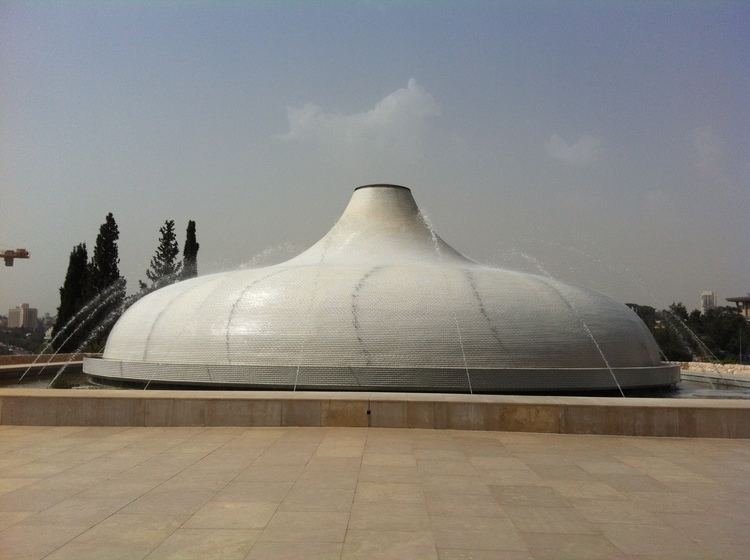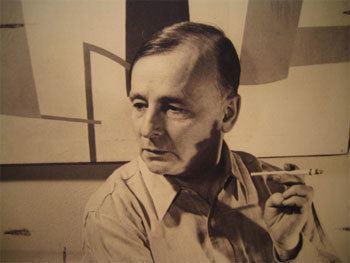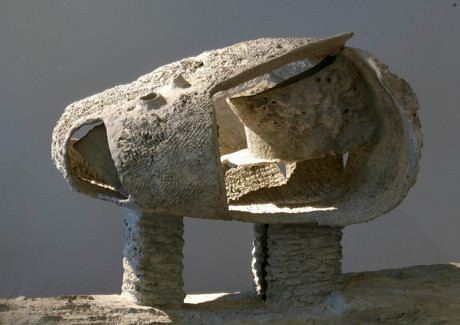Nationality American Name Frederick Kiesler | Role Architect | |
 | ||
Movies 8 × 8: A Chess Sonata in 8 Movements Books Frederick Kiesler, 1890-1965, Frederick J. Kiesler: Selected Writings, Ian Kiaer: Tooth House Similar People Armand Phillip Bartos, Adolf Loos, Hans Richter, Jean Cocteau | ||
Frederick John Kiesler (Czernowitz or Tschernovitz, Austro-Hungarian Empire (now Chernivtsi, Ukraine), September 22, 1890 – New York City, December 27, 1965) (born as Friedrich Kiesler). Austrian-American architect, theoretician, theater designer, artist and sculptor.
Contents
Biography

Beginning in 1908–09, Kiesler studied at the Technische Hochschule in Vienna. From 1910–12, he attended painting and printmaking classes at the Akademie der bildenden Kunste, both in Vienna. He did not finish the architecture curriculum at the Technische Hochschule.

He married Stefanie (Stefi) Frischer (1896–1963) in 1920, and they moved to New York City in 1926, where he lived until his death. Kiesler collaborated there early on with the Surrealists, including Marcel Duchamp. His writing was extensive, and his theoretical work embraced two lengthy manifestos, the article "Pseudo-Functionalism in Modern Architecture" (Partisan Review, July 1949) and the book Contemporary Art Applied to the Store and Its Display (New York: Brentano, 1930).

In 1964, the year before his death, Kiesler married Lillian Olinsey, his longtime secretary. In May 1965, he traveled to Jerusalem for the inauguration of the Shrine of the Book; seven months later he died in New York City.
Design and architectural career
Kiesler was productive as a theater and art-exhibition designer in the 1920s in Vienna and Berlin. In 1920, he started a brief collaboration with architect Adolf Loos and, in 1923, became a member of the De Stijl group in 1923. Kiesler was friendly with many of the major figures of the European avant-garde, which may have influenced his heretical approach to artistic theories and practices.
Kiesler arranged the world premiere in Vienna on September 24, 1924, of the 16-minute film Ballet mecanique, directed by Dudley Murphy and Fernand Leger, with Man Ray. In November 1975, Lillian Kiesler, Frederick's second wife, found Leger's original spliced 35mm, 16-minute version of the film in the closet of their week-end house in the Hamptons on Long Island, near New York City. This version, restored by Anthology Film Archives, has since been included in the documentary film compilation Unseen Cinema: Early American Avant-Garde Film 1893-1941 (released as a seven-disc DVD set by Image Entertainment, October 2005). The music for the film was originally composed by George Antheil, who used it to create a separate concert piece, also named Ballet mecanique, which premiered in Paris in 1926.
His architectural designs include the Film Guild Cinema (1929) in New York City and, with Armand Phillip Bartos, the Shrine of the Book (1965) in Jerusalem, Israel.
From 1937 to 1943, Kiesler was the director of the Laboratory for Design Correlation within the Department of Architecture at Columbia University, where the study program was more pragmatic and commercially oriented than his deep, theoretical concepts and ideas, such as those about "correalism" or "continuity," which concern the relationship among space, people, objects and concepts.
For his object designs, such as the biomorphic furniture in his Abstract Gallery room of Peggy Guggenheim’s The Art of This Century Gallery art salon (1942), for example. For it, he sought to dissolve the visual, real, image, and environment into a free-flowing space. He likewise pursued this approach with his “Endless House,” exhibited in maquette form in 1958–59 at The Museum of Modern Art. The project stemmed from his shop-window displays of the 1920s and his Film Guild Cinema in New York City, mentioned above. Pursuing display and art-gallery work, he was a window designer for Saks Fifth Avenue from 1928 to 1930. Earlier in his career in Europe, Kiesler invented the 1924 L+T (Leger und Trager) radical hanging system for galleries and museums.
His unorthodox architectural drawings and plans that he called "polydimensional" were somewhat akin to Surrealist automatic drawings.
He designed some intriguing furniture, a few pieces of which were featured in the yearbook of the short-lived American Union of Decorative Artists (AUDAC); he was a founding member of the organization in 1930. Some models of the furniture — none of which was reproduced in numbers as intended — have been posthumously manufactured in limited quantities by various firms in Europe since 1990. The most popular has been the cast-aluminum "Two-Part Nesting Table" (1935).
Recognition and awards
Kiesler was often shunned by his peers, although he was chosen in 1952 as one of "the 15 leading artists at mid-century" by The Museum of Modern Art and in 1957 became a fellow of the Graham Foundation in Chicago. Israeli architects disapproved of his and Bartos's serving as the architects for the Shrine of the Book (1957–65) because they were not Israelis, even though they were Jews. Further objections to Kiesler were that he had not completed his architecture studies and had built no structures, despite having been a licensed architect in New York State since 1930. One of his colleagues at Columbia University joked: "If Kiesler wants to hold two pieces of wood together, he pretends he's never heard of nails or screws. He tests the tensile strengths of various metal alloys, experiments with different methods and shapes, and after six months comes up with a very expensive device that holds two pieces of wood together almost as well as a screw".
The Austrian Frederick and Lillian Kiesler Private Foundation was established in 1997 in Vienna and biennially grants the Kiesler Prize for Architecture and the Arts.
